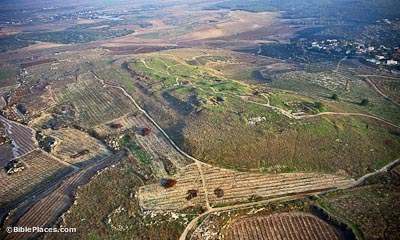 |
| tel of ancient Gezer with kibbutz in right background, courtesy, BiblePlaces.com |
Gezer, originally
a Canaanite town, was conquered by Joshua, but the Canaanite inhabitants were
spared. It was designated a Levitical city, allotted to the tribe of Ephraim
and located at the very edge of the tribal territory. At the beginning of the
10th century BCE, possibly during the reign of King Solomon, Gezer
was conquered by the Egyptians but then the Pharaoh gave it to Solomon as a
present (I Kings ix. 15-17). In the 4th century BCE, the town, along
with the rest of the country, fell under Hellenist rule under Alexander the
Great. It was later populated by Greek immigrants who settled there alongside
the indigenous Jewish inhabitants. At the time of the Maccabees, Gezer, still
under Hellenist rule, became a fortified city under Bacchides, a Hellenist
general, but was conquered by Simon the Maccabee, who drove out the Greek settlers
and their Jewish collaborators and settled it with faithful Jews according to
the Book of Maccabees iv. 15; vii. 45; ix. 52; xiii. 43, 53; xiv. 7, 34; xv.
28; xvi. 1. Under the Roman general Gabinius, “Gazara” became the chief town of
its district.
Gezer
remained inhabited by Jews even after the Roman destruction of Jerusalem but
abandoned a few centuries afterwards. The town eventually became a heap of
ruins in which state in remained for many centuries. By the beginning of the 19th
century, the Arab settlement of Abu Shusha had long been established adjacent
to the site. In 1869, some of the village lands near the ruined site of Gezer (as
yet, not identified as such until 1873) and adjacent to Abu Shusha were
purchased by Melville Peter Bergheim, a banker from Germany who had settled in
Israel many years previously and had later established a bank. According to
rumor, he was born Jewish but had converted to Protestant Christianity as an
adult before settling in Israel. Bergheim established a modern agricultural
farm on his newly-purchased land using contemporary European methods and
equipment. His ownership of the land was hotly contested by the villagers, by
legal and illegal means, including the murder of his son Peter. After the
Bergheim Bank became insolvent in 1892, his land, through an agreed-upon court arrangement,
was managed jointly with a government receiver, Serapion Pasha, a resident of
Jaffa. But legal disputes still plagued the area and in 1913, part of the land
was sold by Serapion to the villagers and the rest to the Jewish Colonization Association,
financially backed by the Baron de Rothschild. Disputes were finally settled
when the JCA and Rothschild gave the Arab villagers one third of
their purchase on a temporary lease basis until more reasonable accommodations
were found. Aside from the legal disputes, Gezer/Abu Shusha was also plagued by
constant attacks by roving Bedouin as well as from poor living conditions. In
1922, the land was sold to the Maccabean Land Company, a British Jewish company
under Norman Bentwich, barrister. In 1945, the kibbutz was established. The earliest
pioneers who settled there were immigrants from Europe,
who named the kibbutz after the biblical city, Gezer, near which was the tel of the ancient town.
On June 10, 1948
during the War of Independence, the day after the Yiftah and Harel brigades attempted
to take the site of Latrun, an Arab Legion battalion, supported by irregulars and
a dozen armored cars, attacked the kibbutz which was defended by only 68
Haganah soldiers. After four hours of battle, the kibbutz fell. 39 defenders and
2 Arab Legionnaires were killed, a dozen kibbutzniks escaped and those who
remained, were taken prisoner. It was then occupied by the Arabs but was later taken
back by two Palmach squads. Because of its strategic location, it
then served as a vantage point in Operation Dani (July 1948), which resulted in
the inclusion of the towns of Ramleh and Lydda (Lod) in the State of Israel. After
the war it was rebuilt, but came apart in 1964 due to social difficulties. The
current kibbutz was founded on 4 July 1974, by a Gar'in group
from North America.
The
kibbutz has developed since and in the ensuing years, it would run various enterprises
including a factory for adhesives
and a special educational park, Ginat
Shorashim, dedicated to peace and the environment and rooted in Jewish
sources. A pumping station of the
Yarkon-Negev water pipeline is located nearby. In 1983, Kibbutz Gezer Field, one of the few
regulation baseball fields in Israel, was established, funded by American
donors as well as by the Jewish National Fund. The first game was played
within a few months. A backstop, covered benches for players and a refreshment
stand were added at a later date. In 1989, a scoreboard and outfield
fence were erected for the Maccabiah Games.
In addition, the Gezer Pool,
temporarily closed as of this writing, was a very popular local recreation site
and is located near the Nahal Azaria.
Since 2014,
a red-hair event has been held at the Kibbutz for the local Israeli red hair
community. However, the number of attendees has to be restricted due to
the risk of rocket attacks (which the Zionist government in Israel refuses to
stop), leading to anger in the red-hair community.
No comments:
Post a Comment